

Trivium. In medieval universities, the trivium comprised the three subjects that were taught first: grammar, logic and rhetoric.
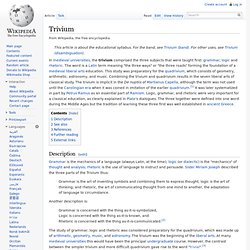
The word is a Latin term meaning "the three ways" or "the three roads" forming the foundation of a medieval liberal arts education. This study was preparatory for the quadrivium, which consists of geometry, arithmetic, astronomy, and music. Combining the trivium and quadrivium results in the seven liberal arts of classical study. The trivium is implicit in the De nuptiis of Martianus Capella, although the term was not used until the Carolingian era when it was coined in imitation of the earlier quadrivium.[1] It was later systematized in part by Petrus Ramus as an essential part of Ramism.
Logic, grammar, and rhetoric were very important for a classical education, as clearly explained in Plato's dialogues. Description[edit] Another description is: See also[edit] References[edit] Further reading[edit] External links[edit] Quadrivium. The quadrivium consisted of arithmetic, geometry, music, and astronomy. These followed the preparatory work of the trivium made up of grammar, logic, and rhetoric. In turn, the quadrivium was considered preparatory work for the serious study of philosophy (sometimes called the "liberal art par excellence")[citation needed] and theology. The word "trivia" has been rarely used to refer to the trivium.[1] Origins[edit] The Pythagoreans considered all mathematical science to be divided into four parts: one half they marked off as concerned with quantity, the other half with magnitude; and each of these they posited as twofold.
Classical education. Classical education may refer to: Waldorf education. Vocational education. Vocational education (education based on occupation or employment), also known as career and technical education (CTE) or technical and vocational education and training (TVET) is education that prepares people for specific trades, crafts and careers at various levels from a trade, a craft, technician, or a professional position in engineering, accountancy, nursing, medicine, architecture, pharmacy, law etc.
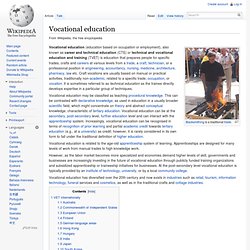
Craft vocations are usually based on manual or practical activities, traditionally non-academic, related to a specific trade, occupation, or vocation. It is sometimes referred to as technical education as the trainee directly develops expertise in a particular group of techniques. Vocational education is related to the age-old apprenticeship system of learning. Apprenticeships are designed for many levels of work from manual trades to high knowledge work. VET internationally[edit] Australia[edit] Commonwealth of Independent States[edit] European Union[edit] Mastery learning. There is a school of thought that presumes all children can learn if they are provided with the appropriate learning conditions.
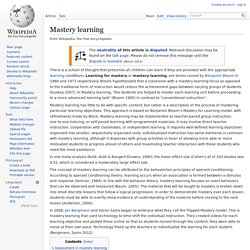
Learning for mastery or mastery learning, are terms coined by Benjamin Bloom in 1968 and 1971 respectively. Bloom hypothesized that a classroom with a mastery learning focus as opposed to the traditional form of instruction would reduce the achievement gaps between varying groups of students (Guskey 2007). In Mastery learning, "the students are helped to master each learning unit before proceeding to a more advanced learning task" (Bloom 1985) in contrast to "conventional instruction".
Socratic method. Type of dialog or debate The Socratic method is a method of hypothesis elimination, in that better hypotheses are found by steadily identifying and eliminating those that lead to contradictions.
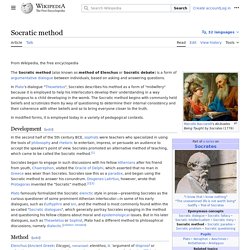
The Socratic method searches for general, commonly held truths that shape beliefs and scrutinizes them to determine their consistency with other beliefs. The basic form is a series of questions formulated as tests of logic and fact intended to help a person or group discover their beliefs about some topic; exploring definitions, and seeking to characterize general characteristics shared by various particular instances. Suggestopedia. Suggestopedia (US English) or Suggestopædia (UK English) is a teaching method developed by the Bulgarian psychotherapist Georgi Lozanov.
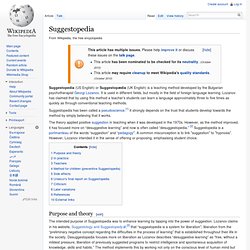
It is used in different fields, but mostly in the field of foreign language learning. Lozanov has claimed that by using this method a teacher's students can learn a language approximately three to five times as quickly as through conventional teaching methods. Suggestopedia has been called a pseudoscience.[1] It strongly depends on the trust that students develop towards the method by simply believing that it works. Emergent curriculum. Emergent curriculum is a way of planning curriculum based on the student’s interest and passions as well as the teacher’s.

To plan an emergent curriculum requires observation, documentation, creative brainstorming, flexibility and patience. Rather than starting with a lesson plan which requires a “hook” to get the children interested, emergent curriculum starts with the children’s interests. This is not to say that the teacher has no input, in fact teachers may well have a general topic they think is important for children to study and they may purposely include certain materials or experiences related to it as jumping off points. Elizabeth Jones points out: We are the stage directors; curriculum is teacher’s responsibility, not children’s. This process requires a great deal of flexibility and creativity on the part of the teacher. Once teachers see an interest “emerging” they brainstorm ways to study the topic in depth.
Sources Booth, Cleta. Gonzalez-Mena, Janet (2011).